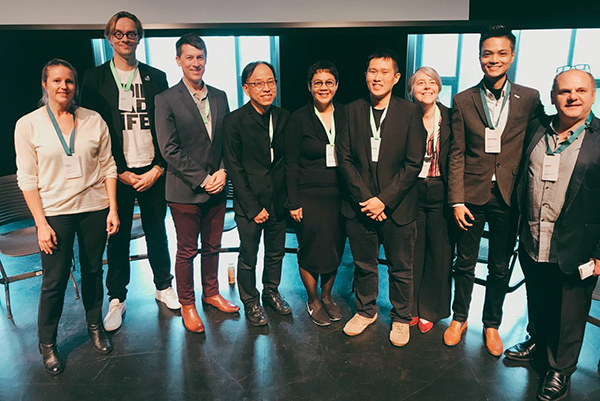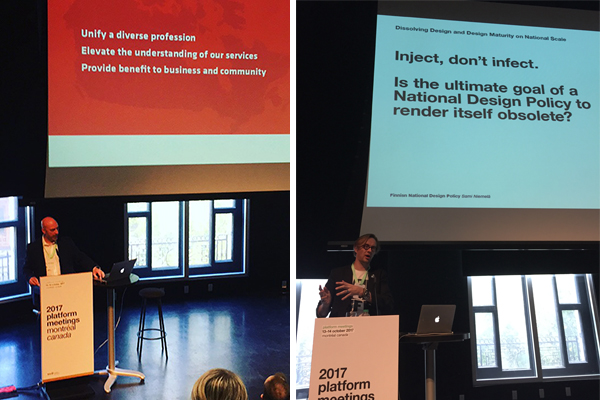
30 Oct From Design Certification to National Design Policies
ico-D Platform Meeting and World Design Congress
International Council of Design (ico-D) is an international organization of graphic arts associations; their annual Platform Meeting took place October 13 and 14 in Montréal, Canada this year, and as in previous years Rebecca Blake represented the Guild and participated as the National Design Policy workgroup lead. The Platform Meetings are organized for the international members of ico-D’s Education Platform (design educational institutions and programs) and Professional Platform (design associations) to review presentations and discuss issues of concern to designers and design educators. It’s an excellent opportunity to meet with one’s peers and gain an international perspective on common issues.
This year’s Platform Meetings kicked off with presentations by RGD (Association of Registered Graphic Designers), GDC (Graphic Designers of Canada), and Chartered Society of Designers. Each association conducts a robust certification program for designers, unique in how the qualifications and knowledge base of the participating designers is evaluated. The subsequent discussion between Hilary Ashworth of RGD and Jonathon Strebly of GDC was particularly illuminating. The two associations, both based in Canada, conduct certification programs and in the past have had a competitive and at times rancorous relationship. The discussion focused on how the two associations seek to best to serve professional designers in Canada.

Food for thought: Jonathon Strebly describes the mission of GDC’s designer certification program (left), while Sami Niemäla asks a provocative question raised by Finland’s successful national design policy.
Another presentation that stood out was from the INDIGO, the Indigenous Design Network. In fact, one of INDIGO’s ambassadors, Elly Chatfield, initiated a new ritual for ico-D meetings. As a member of the Kamilaroi people of Australia, Chatfield opened the meeting with an Acknowledgment of Country rite, honoring the first people of Montréal and Québec. Russell Kennedy and Meghan Kelly from Deakin University in Australia reported on INDIGO’s activities and on their flagship project, the International Indigenous Design Charter, which was launched six days later at the World Design Congress. The International Charter will build on the existing Australian Indigenous Design Charter, and be a best practices guide for designers on using indigenous design and imagery accurately and respectfully. (A full interview of Kennedy and Kelly can be read on the ico-D website.)
For the Guild, the half-day session on National Design Policy (NDP) culminated three years of heading the NDP workgroup for ico-D. (A report on the NDP workgroup can be read on our website.) Members of the workgroup and invited speakers covered design policies from inception to full evolution and evaluation. Zachary Haris Ong from Malaysia and ZInna Nizar from Indonesia covered the first stop-and-go steps in getting an NDP initiated in their countries. (The task can be daunting; in Indonesia, as Nizar reported, design is not recognized as a profession, and designers are prohibited from charging for any services that don’t yield tangible outcome, such as a printed piece.) Bradley Schott and Peter Florentzos spoke on the stalled attempt at an Australian NDP, and a revamp of a regional design policy in Queensland.
On the side of fully realized NDPs, Tyra von Zweibergk (Sweden), Sami Niemäla (Finland), Kelvin Tan (Singapore), and Don Ryun Chang (South Korea) discussed their countries’ NDPs. The discussions illuminated how much political, economic, and even cultural differences shade the structure and execution of the policies. In fact, Niemäla’s presentation made the startling supposition that the function of a design policy is to make itself irrelevant. From his report, the NDP in Finland was so successful, with public awareness of design and with the design thinking so well integrated into the private and public sector, that Finland has scrapped plans to create a national design center.
As with the INDIGO presentation, the NDP presentation was reprised for the World Design Congress later in the week. However, because of the limited time allotted, we focused on a guided Q&A conducted by Alisha Piercy, Communications Officer of ico-D. Ong, Florentzos, and Tan were joined by Mariano Alesandro of INDEX: Design to Improve Life in Denmark, and Arlene Gould from DIAC (Design Industry Advisory Committee) in Ontario, Canada. Alesandro spoke from the perspective of yet another highly evolved NDP from a Nordic state, while Gould represented the point of view from a country making its’ first steps towards an NDP. The audience included a mix of designers, policy makers, and educators. We were particularly delighted to entertain a question from Dori Tunstall; Tunstall led a US-based initiative on NDP in 2008-2010, which, while unsuccessful, yielded interesting insights into the US political structure and character, and how that influences our design sector.

Zachary Haris Ong and Rebecca Blake at the outset of the NDP presentation at the World Design Congress.
At top of page: The NDP presenters represented a broad range of countries: (left to right) Tyra von Zweibergk (Sweden), Sami Niemäla (Finland), Bradley Schott (Australia), Don Ryun Chang (South Korea), Zinnia Niza (Indonesia), Kelvin Tan (Singapore), Rebecca Blake (USA – Graphic Artists Guild representative to ico-D), Zachary Haris Ong (Malaysia), and Peter Florentzos (Australia).
